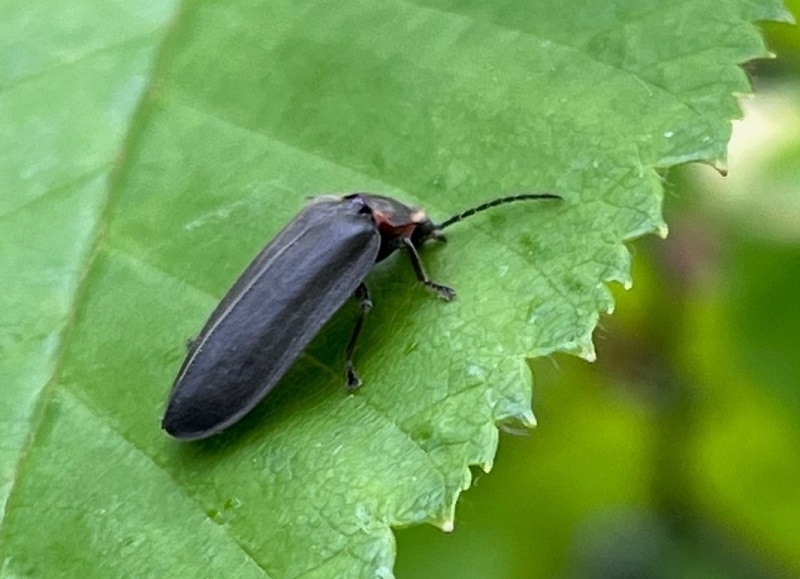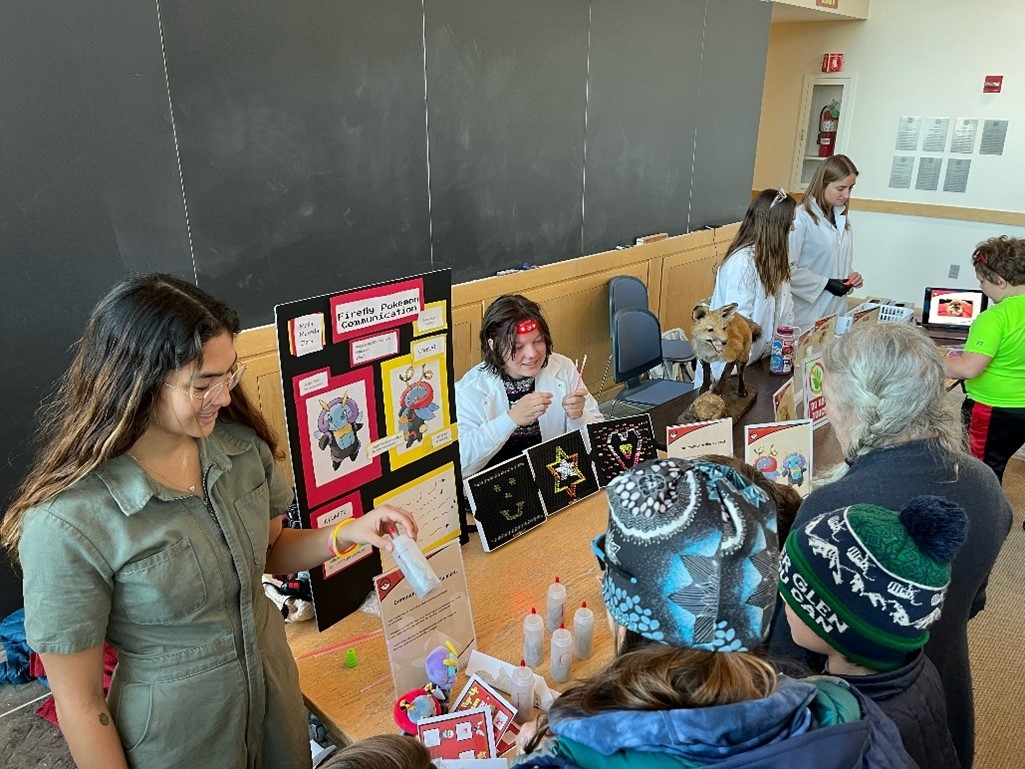Middlebury professor's grant research signals evolutionary shifts in firefly communication

Whether it’s a business or a relationship, communication is undoubtedly the life force behind most successful endeavors. In animals, it’s essential. Effective communication helps to grow, protect, and sustain species, ultimately contributing to their survival.
That’s why when Gregory Pask heard that some firefly species reverted to a different communication method, he jumped at the opportunity to further explore the topic.
At Middlebury College, Pask is a biology professor who teaches undergraduate courses like Cell Biology and Genetics, Receptor Biology, and Entomology, the study of insects. Specifically, Pask is an insect neurobiologist, which means he studies how insects function and interact with other organisms. Some topics that Pask has tackled include studying the chemical language of ants, monitoring the pheromone reception of longhorn beetles, and exploring the molecular mechanisms of mosquitoes and how they smell.
“I was drawn to this field [insect neurobiology] because I appreciated the reduced complexity of insect systems. But there’s still so much we don’t know,” said Pask.
In the past, Pask’s research has been featured in several publications as well as presented at symposiums and universities, such as the University of New York and Cornell University. He’s also received grants from the National Institute of Health (NIH).
“This is just an incredible evolutionary phenomenon to have certain species lose their namesake flash signal as adults,” said Pask. “And, as someone interested in insect communication through pheromones, it’s exciting to investigate a group of firefly species that decided pheromones were for them as well!”
His recent grant, though, further explores how some firefly species changed their communication method—from flashing lights to producing pheromones. This project was supported by a grant from the National Science Foundation (NSF). Pask and his team submitted their proposal in May 2020. They received this NSF grant around March 2021.
The research team includes Sarah Lower, a biology professor at Bucknell University; Doug Collins, a chemistry professor from Bucknell University; and Jocelyn Millar, an entomology professor at the University of California Riverside (UCR). The team is supported by several undergraduate assistants from Middlebury and Bucknell, and graduate students and postdoctoral fellows from UCR, too.
“This is just an incredible evolutionary phenomenon to have certain species lose their namesake flash signal as adults,” said Pask. “And, as someone interested in insect communication through pheromones, it’s exciting to investigate a group of firefly species that decided pheromones were for them as well!”
In general, animal communication can be separated into two types of signals. One is called a unimodal signal, a singular way of communicating, such as sound, touch, sight, or chemical. The other is multimodal, a more complex form that involves a combination of senses or actions, such as singing, licking, or stroking. For example, cicadas use unimodal signals—males produce a specific frequency to attract females. Meanwhile, fruit flies use a multimodal signal—they combine smell, taste, touch, audio, and visual signals during mating rituals.
Typically, fireflies use a unimodal visual signal: a flashing light or glow that is produced and controlled by a special organ in their abdomens. This light intermittently appears and exists from birth—throughout the egg, larvae, and pupal stages—and becomes brighter after metamorphosis in adulthood. The light helps to deter predators, mate, and share essential information, such as territory or food sources. For instance, male fireflies will emit a light, female fireflies will reply with a light, and the two will exchange signals in a “flash dialogue” until the male firefly can find the female.
However, recent research has indicated that there are at least five different lineages of North American fireflies that do not emit light as adults. Rather, in place of flash dialogues, “unlit” fireflies are believed to be using pheromones as a communication tool. They are also active during the day. In addition, unlike their nighttime counterparts, mating is initiated by the female firefly, who uses pheromones across long and short distances to communicate with the male.
“This work with fireflies will help us understand some of the evolutionary steps that can lead to such drastically different communication strategies in many other animal species.”
Pask is using his NSF grant to better understand how and why this change occurs.
“It is very risky to change your mating communication strategy. Half measures with only one sex making the change will not result in a successful outcome. It truly does take two!” Pask said. “This work with fireflies will help us understand some of the evolutionary steps that can lead to such drastically different communication strategies in many other animal species.”
In 2021, Pask’s team collected lit and unlit fireflies in at least seven sites throughout Vermont, North Carolina, Pennsylvania, and Tennessee. One of the captured “unlit” fireflies was the winter firefly, Photinus corruscus. With a wide range across North America, Photinus corruscus derives its name from its unique lifecycle where they overwinter as adults instead of larvae as most fireflies do. In Vermont, this species is well known to maple sugarers, as emerging adults frequent the sweet sap flows during the sugaring season.
The team identified the sex pheromone in the Photinus corruscus. Then, these winter fireflies were sent to the UCR lab, where females were placed in mason jars connected to an aquarium pump, which collected the odorants being released by the firefly. From here, the UCR team determined which odorant mixtures contained pheromones by testing if and how each pheromone activated the male’s firefly antennae. It was discovered that a molecule named hydroxycamphor yielded the most activation. So, the UCR team created a synthetic version of the molecule and sent it back to Middlebury for behavior trials.
In Spring 2021, Middlebury and Bucknell researchers created sticky traps with this synthetic pheromone lure to see if hydroxycamphor alone was enough to attract fireflies. Pask also used a technique called electrophysiology to probe what exact structures were sensing the pheromone on the antennae. After 24 hours, the team found that each pheromone trap with hydroxycamphor captured loads of winter firefly males. Traps without pheromones had zero.
This discovery represented the first firefly pheromone ever identified, a highlight that was recently reported in the Journal of Chemical Ecology.

“Nature can tell us such wonderful stories when we become a more captive audience.”
In the future, Pask and his team hope to use a similar approach to identify the pheromones of other “unlit” firefly species. They also plan to dive deeper into the firefly’s sensitive antennae and how it can smell such small quantities of pheromone. According to Pask, by finding more species, the researchers can start to build an evolutionary story around the process of overhauling an entire mating communication strategy, which can extend beyond insects and other animals.
For now, though, Pask’s research experience is emerging as learning opportunities in the community and as case studies in his animal physiology and entomology classes. Some of his students even have found creative ways to engage with the research, such as participating in the Fall 2022 “Poké-Pop Up Museum,” a community event put on by Middlebury Entomology and Mammalogy students, where Vermonters of all ages could learn about real wildlife and the world of Pokémon. At this event, two-firefly-inspired Pokémon—Illumise and Volbeat—were used as examples to explain visual and pheromone signals to children.
“It [The Poke Pop-Up Museum] wonderfully demonstrates how real-world phenomena can trickle into popular culture,” said Pask. “Our students rose to the occasion and found creative ways to use Pokémon as a storytelling lens to engage the community the natural world. Nature can tell us such wonderful stories when we become a more captive audience.”

